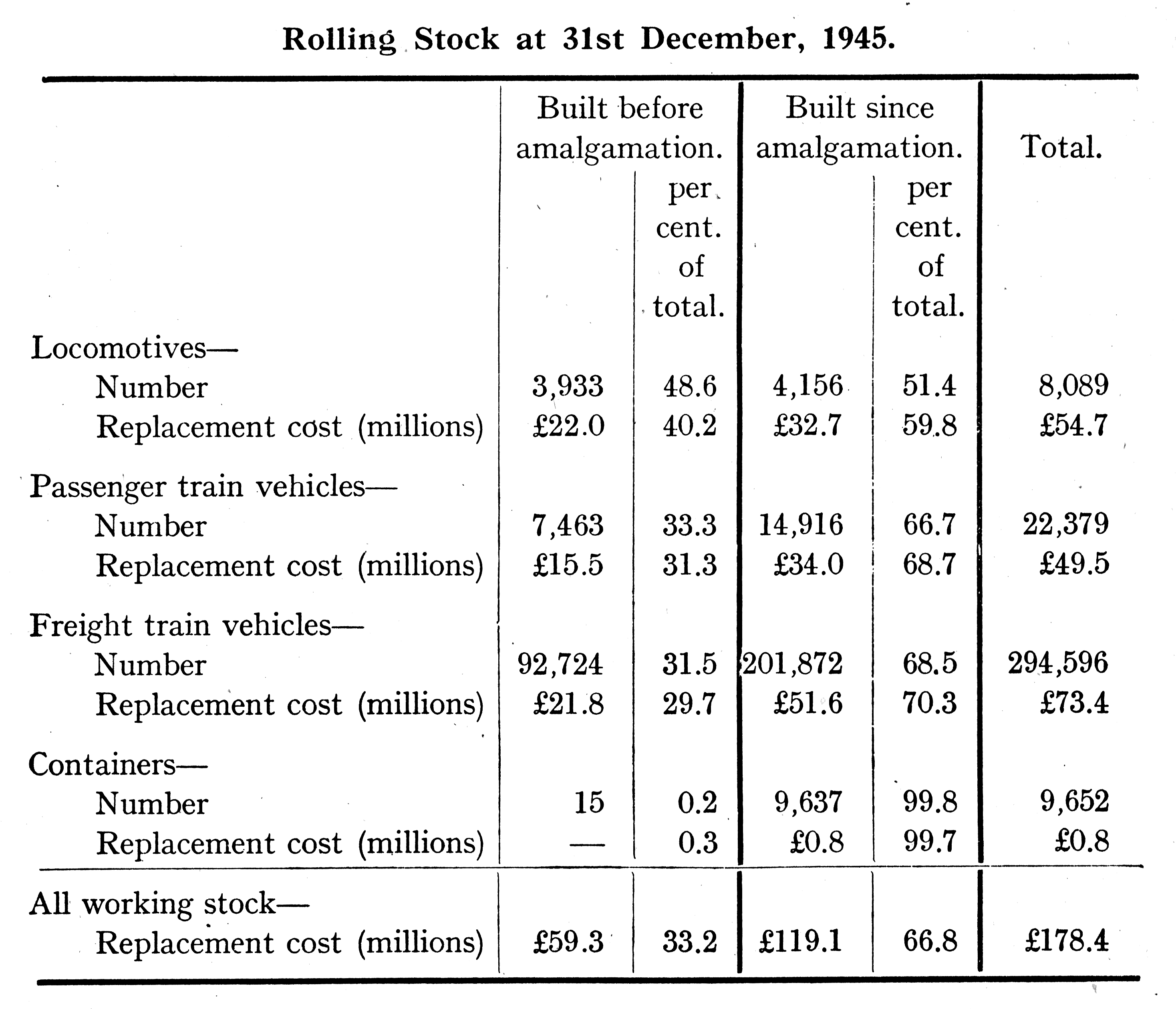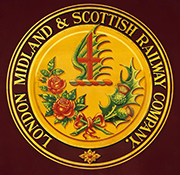

This site uses non-intrusive cookies to enable us to provide a better user experience for our visitors. No personal information is collected or stored from these cookies. The Society's policy is fully explained here. By continuing to use this site you are agreeing to the use of cookies.
From the track and structures, we turn now to the rolling stock, which represents an investment of £180,000,000.
Since 1923 there has been great improvement in design and in the methods of rolling stock maintenance and manufacture. The locomotive designer aims at securing reliability in use, adequate power for the load to be drawn, efficiency in coal consumption and high availability for service. From 1923 onwards the replacement of locomotives was undertaken boldly; new designs embodying important changes from past practice were produced, and works procedure was fundamentally altered. For example, the largest of the company's standard types of locomotive-the 4-6-2 passenger tender shows a fuel saving of 40 per cent. compared with typical earlier heavy express locomotives; in fast running the modern locomotives have an increase in power of from 10 to 30 per cent. compared with previous locomotives of similar weight. The possibilities of radically new designs have been studied; tests have been made with a condensing turbine locomotive and with one employing a boiler pressure of 900 lbs. per square inch. A non-condensing turbine locomotive, was built for experimental purposes and is still in operation-the only unit of its kind in extensive regular service in this country.
An important step was taken in 1937 when the L.M.S. and L.N.E. Companies decided to set up a locomotive testing plant at Rugby, but the outbreak of war prevented its completion and also that of a mobile test plant. In the Rugby plant it will be possible to simulate actual running conditions and to carry out a far more careful analysis of a locomotive's performance than is possible when it is running on the track. Other measurements can be taken better under actual running conditions, and the mobile plant will enable this to be done with accuracy.
In 1923 the L.M.S. had 10,316 locomotives of many different designs, which fell into about 400 different classes. At the end of 1945 the stock had been reduced to 8,049 steam and 40 diesel locomotives comprising 133 classes. Of these 8,049 steam locomotives, 4,438 fall into the 17 classes which are the company's standard types. With reduced numbers, however, the average daily mileage of each locomotive increased between 1923 and 1938 by 30 per cent. This better use arose partly from improvement in the rostering of locomotives which increased the time in service and partly from changes in repair procedure which reduced the time out of service. The war and its effects have retarded this process of modernisation, but it is now being resumed. Table 8 of the statement of financial and statistical results in the middle of this pamphlet shows in graphic form the results achieved.
Time spent in the running sheds has been considerably reduced, and the provision of good boiler water reduced the servicing which the boilers require. The greatest improvement, however, has been made in the time spent in the company's main works during heavy overhauls. This was achieved by a complete change of practice in the company's works, which in addition to reducing the stock of locomotives needed, enabled several of the smaller works to be closed since the output from the main works-Crewe, Derby, Horwich and St. Rollox-could be increased sufficiently to meet the needs of the whole system. This essential change of practice was the introduction of a "progressive" system of repair. Formerly each locomotive entering a works was dealt with on an .individual basis; it remained at one point and its overhaul could not be completed until all its various parts had been returned from the different shops to which they had been sent for repair. Under the new system, the locomotive moves through the erecting shop in a series of steps according to a strict schedule, at each stage the allotted part of the work being completed by a set time. This provides a strong safeguard against delay, not only in the erecting shops but also in the subsidiary shops which deal with the components. Several other innovations have played complementary but essential parts; the chief of these was the setting up of a standard range of boilers and the maintenance of a stock of spare ones, to avoid a locomotive waiting the return of its original boiler from the boiler shop.
Apart from boilers, the standardisation of the design of components generally has been of great assistance in preventing waste time in the shops. This standardisation of design is coupled with the standardisation of manufacture and repair tolerances known as "limits of fit " so that the products of all the company's works are interchangeable. Similarly the decision whether worn parts should be replaced or repaired is made by reference to scheduled "limits of wear." These were compiled over a period during which a system of individual costing of repairs to all components was in force, thus making possible an economic as well as a technical analysis of the work which has resulted in substantial savings through the avoidance of uneconomical repairs. These "limits of wear" have a second function as the tables also show whether a component needs repair or not, thus avoiding unnecessary repair work due to individual differences of judgment.
The company pioneered the development of the diesel shunting locomotive in this country, and but for the outbreak of war would now possess a comparatively large fleet. The first unit was put into service in 1932, and it was followed by seven others, all relatively light units, but which afforded useful experience. In 1934 trials were made with two heavier units with electric transmission and these proved to be the forerunners of the type which was eventually standardised. Eighty units of this type have since been built but about half of them have been taken for war purposes. They have engines of 350 h.p. and are capable of any shunting duty required on the system. Very close attention has been paid to maintenance procedure and methods, with such success that the availability for service, taking into account time spent in major overhauls, represents 150 of the 168 hours in the week.
Carriage design has developed during the past 23 years from a wooden body mounted on a riveted underframe and bogies to the one with steel body and roof panels welded to an underfrarne and with bogies of welded construction. Its clean-cut appearance is due to the flush finish made possible by the welding of the panel joints. Improvements inside the coaches include armrests and shoulder lights in third-class compartments : better ventilation and elimination of draughts by use of sliding windows instead of large drop windows; the use of decorative timbers and modern, upholstery materials; adoption of double sliding doors to compartments; the fitting of larger windows in both compartments and corridors; improved lavatory accommodation.
Whilst the major development in wagon design has been the gradual elimination of wooden underframes in favour of steel, entirely new types of wagon stock have been introduced, including shock absorbing wagons for fragile traffics such as sanitary tubes, hard and hollow ware and sheet glass: rail and road-rail tanks for conveyance of milk and other liquids in bulk; containers for door-to-door transport; high-capacity wagons and wagons. for special traffics.
Progressive systems for the construction and repair of carriages, wagons and containers were introduced in the main workshops during the years immediately following the amalgamation, involving, in the aggregate, a considerable outlay on new machinery and plant. The system as well as expediting erection and repair operations from start to finish, and creating economies in time and labour, provides for the erection or repair of the maximum number of vehicles with the minimum amount of shop space, and this has made possible substantial increases in output from existing works. The introduction of these methods resulted in a reduction in the cost of building carriages of from 17 to 26 per cent. dependent on the type concerned. The cost of building open and covered wagons fell by 30 per cent. Repair costs were reduced by 30 per cent. for carriages and 15 per cent. for wagons.
The following table shows the various types of rolling stock at 31st December, 1945, divided between those built before the amalgamation in 1923 by the constituent companies and those built since by the L.M.S.

It will be seen that of the total rolling stock at the end of 1945, no less than 67 per cent. in cost (or £119. millions) has been provided since amalgamation, which was the main reason why the stock stood up so well during the war. This huge work was done despite the legal difficulties under which the railways were required by Parliament to work and the years of economic disturbance.
Site contents Copyright © LMS Society, 2024

May 10th, 2024
Site contents Copyright © LMS Society, 2024